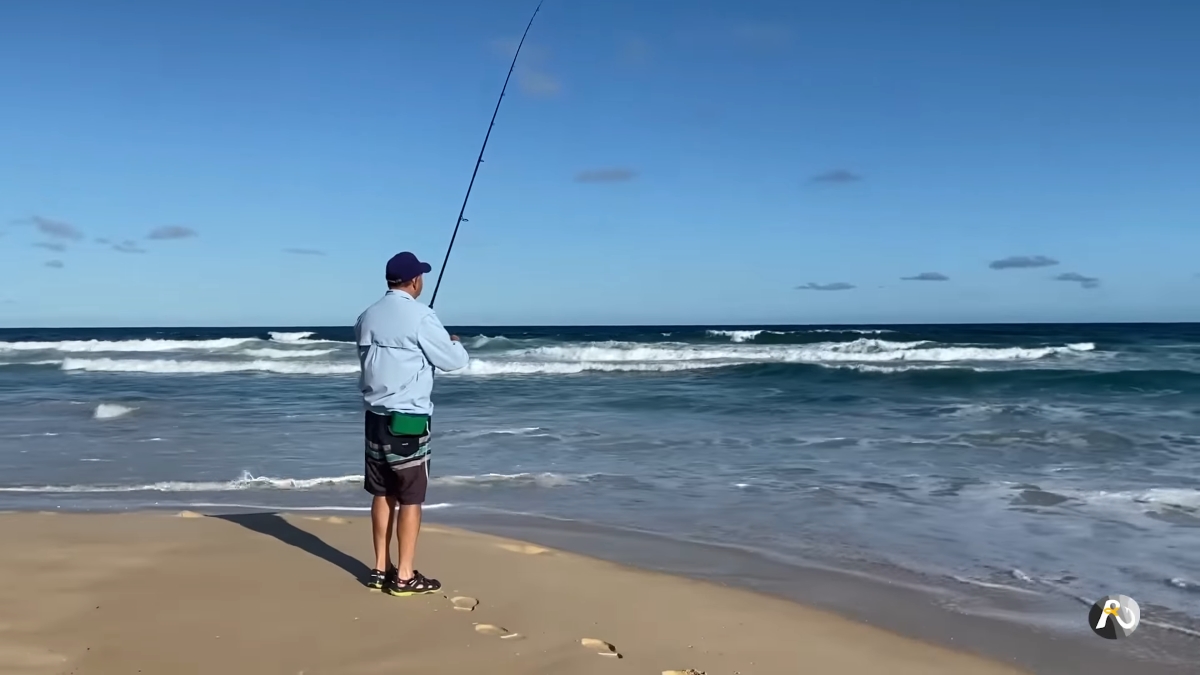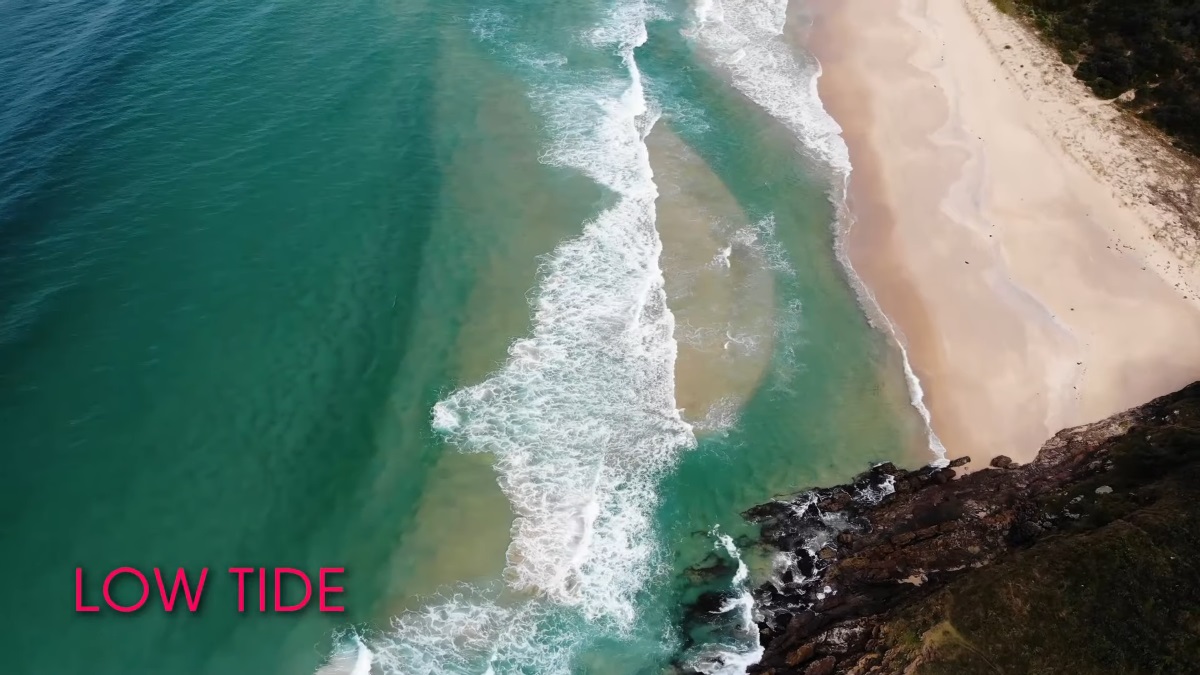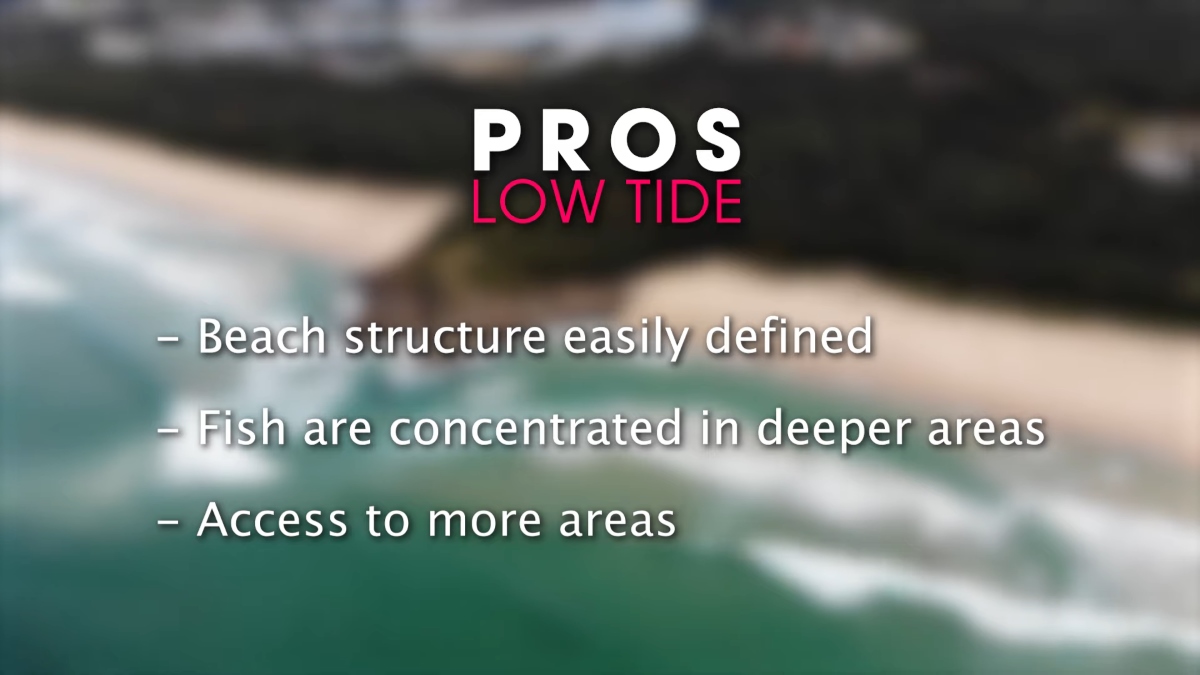Fishing can be an incredibly rewarding experience – the thrill of feeling a tug on your line, waiting with anticipation to see what kind of fish awaits you
But have you ever tried fishing at low tide? Is It Worth Fishing At Low Tide? Low tide can bring special opportunities for anglers, but it poses unique challenges as well.

If done right though, you could find yourself just minutes away from more memorable catches and bigger stories to share with your fishing buddies. Join us today as we discuss whether or not it’s really worth it to venture out into the waters during those lower tides!
Table of Contents
What Is Low Tide?

Before finding the main question: “Is it worth fishing at low tide”, we’ll explore the definition of low tide.
Low tide is the lowest level of water that is reached in a body of water at any given time. Low tide occurs when the gravitational pull from the moon and sun combine to make the ocean levels drop to their absolute lowest levels. This phenomenon creates an exposed area of shallow water which reveals sandbars, rocks, coral reefs, and even shipwrecks in some cases.
Low tide is an interesting event to observe. Different times of the year and different locations around the world can experience dramatically different low tides. The water level in certain bodies of water fluctuates in response to the changing gravitational pull of the moon throughout its lunar cycle. During a full or new moon, these extreme low tides are commonly referred to as “king tides” due to the sheer size of the water level drop.
Low tide presents an excellent opportunity for both adventurers and beach enthusiasts, allowing access to areas that are typically inaccessible during high tide. When visiting a beach or any water body, it’s crucial to be mindful of tide timings. Tides can change rapidly and pose risks if one is not attentive.
Low tide is a captivating natural occurrence, offering an excellent opportunity for exploration or simply unwinding by the shore. Whether you opt to seize the chance to uncover new wonders or bask in the sheer magnificence of the moment, it’s undeniable that low tides usher in distinctive and memorable experiences.
So, Is It Worth Fishing At Low Tide?
Low tide can be a great time for fishing. As water levels decrease, fish start migrating to shallow areas where they have a higher chance of discovering food and other nourishing resources.. This means that anglers can have better luck finding a catch during low tide.
Keep in mind that certain fish might steer clear of specific areas during low tide, necessitating some repositioning on your part to locate them. Moreover, particular fish species exhibit heightened activity during high tide, proving challenging to capture when the tide is low.
Despite these potential obstacles, fishing at low tide is still worth trying. It presents a chance to venture into an alternative angling approach and relish the distinctive allure of the ocean during its ebb. Moreover, there’s a constant possibility of landing a substantial catch!
In general, regardless of whether you’re a seasoned angler or a beginner, it’s valuable to engage in fishing during low tide. This gives you the opportunity to test your luck, embrace a unique oceanic experience, and potentially reel in some catches.
May you like: Best Surf Fishing Reels For The Money, Reviews 2023.
How Can Low Tides Impact Fishing?

After knowing the answer to the question “Is it worth fishing at low tide?”, we’ll discover the effect of fishing at low tide.
As mentioned before, low tide can be an ideal time for fishing. Nonetheless, it’s crucial to keep in mind that reduced water levels can induce alterations in the conduct of fish and other aquatic organisms.
During low tide, specific fish varieties might relocate from shallow areas to deeper ocean regions in search of food. Consequently, anglers could face challenges in capturing these fish since they might no longer inhabit the usual fishing grounds targeted by fishermen.
Additionally, low tides can also cause changes in water temperature and salinity, which can affect certain species of fish. Warm-water fish like tuna may become more active during a warm spell caused by a low tide, while species that prefer cooler waters may move away from the area.
In the end, low tides can present an excellent fishing opportunity. However, it’s crucial to remain vigilant about any shifts in behavior that might arise due to the fluctuations in water levels. Paying attention to these phenomena can help you find success as an angler during a low tide period.
Which Tide Is Best For Fishing?
The best tide for fishing depends on the type of fish that you’re targeting and the conditions of the area. Generally speaking, mid-tide is a great time for most types of angling, as it provides enough water to access different areas while also allowing you to take advantage of any potential changes in behavior among certain species.
When fishing in saltwater, high and rising tides are usually the best conditions for catching certain types of fish. As the tide comes in, it brings with it an abundance of baitfish which can attract larger species like bluefish or mackerel.
In freshwater, low and falling tides are often the most productive for fishing. The lower water levels make it easier to access shallow areas where some species may be hiding, such as bass or pike.
What Are The Main Advantages Of Low Tide Fishing?
Low tide fishing can provide some great opportunities for anglers. As the water levels drop, it reveals new areas and makes certain species of fish more accessible. This means that anglers can explore different parts of the ocean or lake that may normally be inaccessible during high tide periods.
In addition to this, low tides can also offer some unique experiences. During low tide, the water level recedes, offering an excellent opportunity for exploration and discovery. This is the perfect time to uncover hidden gems like coral reefs or previously concealed shipwrecks that might have been obscured during high tide.
Low tides also offer some benefits when it comes to fishing. As previously mentioned, specific fish species tend to migrate toward shallower waters during periods of low tide, which increases their visibility and catchability.
Finally, low tides can be great for just relaxing on the beach or taking in the beauty of nature. As the tides ebb, it presents a wonderful opportunity to relax and truly savor the myriad gifts the ocean bestows upon us.
What Are Some Of The Best Baits To Use When The Tide Is Low?
When angling during low tide, selecting the appropriate bait is crucial for successfully hooking your desired species. While worms and small crabs are effective for a variety of fish, there are additional choices to consider based on your target species and the specific conditions of the fishing location.
For saltwater fishing, shrimp and squid can be great options. These lures are incredibly appealing to various fish species and also offer a substantial nutritional resource.
When fishing in freshwater environments, consider employing crayfish or minnows as your bait choices. These smaller organisms tend to attract specific fish species like bass or pike and can also serve as a nourishing food source for them.
Which Fish Can You Catch At Low Tide?
The fish available for catch during low tide will vary based on the local conditions. In general, specific species such as flounder or sea bass tend to migrate towards shallower waters when the tide is low, enhancing their visibility and catchability.
In saltwater areas, species such as tuna, mackerel and even sharks may be more active during a low tide period. This is due to the warm water temperatures created by the lower tides, as well as the abundance of baitfish that can attract larger species.
In freshwater areas, bass and pike are often found in shallow waters during low tide periods. These fish are drawn to these areas due to their hiding spots or foraging opportunities.
Can you like: 10 Best Surf Fishing Lures, Baits, Surf Jigs & Plugs
How Can You Tell Whether The Tide Is Low Or High?
One of the easiest ways to determine whether the tide is low or high is to check the tide charts. These can be found online or in some areas, at local marinas.
The charts will show you the exact times when high and low tides occur – as well as the predicted water levels in that area. This enables you to strategically schedule your fishing excursions and provides insight into optimal fishing times. Additionally, you can observe specific indicators along the shoreline that signify either low or high tide conditions. During a low tide period, the waterline will be lower than normal – revealing more sand and any nearby rocks or debris. You may even be able to spot certain fish species that are only visible at low tide.
On the other hand, high tides will bring higher water levels and any hidden objects or debris may be covered up. You may also spot different kinds of fish species at this time – as they could be more active due to the conditions.
Can you like: When is the best time to surf fish on the beach?
How Do You Prepare For Fishing At Low Tide?
When engaging in fishing during low tide, it’s crucial to observe specific precautions to optimize your chances of success.
- First, make sure that you’re aware of any potential changes in behavior among certain fish species due to the changing water levels. You can achieve this by investigating the fish species present in the region and observing any changes that occur during low tide.
- Second, make sure to have the right type of bait in order to appeal to the target species – as previously mentioned, worms and small crabs should generally work well for most kinds of fish.
- Third, be aware of any potential obstacles or hazards that may be revealed due to the lower water levels. This includes items such as rocks or debris that could cause harm to yourself and the fish.
- Be sure to assess the weather conditions before embarking on your fishing expedition. Factors like wind or rain can influence the outcome of your fishing endeavor.
By taking these precautions into consideration, you’ll be well-prepared for a successful day of low tide fishing!
| Preparation Aspect | Details and Considerations |
|---|---|
| Fish Behavior Awareness | – Investigate fish species in the region. – Observe behavior changes during low tide. |
| Bait Selection | – Use the appropriate bait for target species. – Worms and small crabs are generally effective for most fish types. |
| Awareness of Obstacles | – Watch out for rocks or debris revealed during low tide. – Avoid potential hazards to ensure safety. |
| Weather Assessment | – Check for factors like wind or rain. – Weather conditions can significantly impact the success of fishing. |
What Tips For Security Do You Have For Fishing At Low Tide?
When engaging in fishing activities during low tide, it is crucial to implement specific safety precautions to guarantee your well-being. To begin, consistently ensure that you are knowledgeable about the tide patterns and their potential impact on the fishing location in question. This means checking the forecasts and taking note of any potential changes in water levels so that you can adjust your strategy accordingly.
Furthermore, when fishing during low tide, it’s advisable to have a companion with you. This way, you can watch out for each other and prioritize safety above all else.
Be certain to dress according to the area’s conditions. Opt for lightweight attire during the summer and thicker layers in winter to guard against possible risks like seasickness or hypothermia. Lastly, remember to carry a safety kit containing essentials like a first aid kit, flares, and other emergency gear.
FAQs
What Is The Cause Of The Tides?
The tides occur because of the gravitational attraction exerted by both the moon and the sun on the Earth’s surface. As these forces interact, they create a rise and fall in sea level which results in high and low tide periods.
Are High And Low Tides Always The Same?
No – although there are patterns that generally follow a certain schedule, there can be variations due to changes in wind and weather patterns. Before you set out, make sure to consult the local tide charts. This will provide insights into the optimal fishing times.
Do Fish Bite More Effectively At High Or Low Tides?
The activity pattern of fish and its correlation with tides varies based on the species and fishing location. In most cases, certain species exhibit higher activity levels during either high or low tide. Therefore, conducting research on the specific fish types present in the area is crucial before embarking on your fishing trip.
What Is The Duration Of High Tide And Low Tide?
The length of both high and low tides can vary due to factors like weather conditions. Generally, high tides usually last around six hours, while low tides can extend for up to twelve hours. It’s advisable to consult local tide charts in advance, as they provide insights into the optimal fishing windows within the specific region.
When Is The Ideal Time To Redfin Fish?
Redfin are most lively during the evening and early morning hours. Therefore, it’s optimal to focus your efforts on pursuing them during these periods. You can accomplish this by consulting the local tide charts to identify the timings of high and low tides. This information will provide insights into the windows when they are more prone to engage in feeding behaviors. It’s also important to consider the weather conditions, as redfin can be more active when the conditions are calm.
What Are Some Cons Of Fishing At Low Tide?
Some of the cons associated with fishing during low tide include: the risk of getting stranded due to rapidly changing water levels, potential hazards such as rocks or debris that may be revealed due to lower water levels, and difficulty in finding the right kind of bait for certain species. Considering these factors when organizing your fishing expeditions is essential, as they can impact your rate of success.
How Can You Find Fish During The Tides?
Locating fish during low tide might pose a challenge, but employing a few strategies can prove beneficial. One of the most effective methods involves identifying spots where the water holds greater depth and exhibits reduced movement. These conditions often create a more favorable environment for specific fish species.
You can also check out areas where the waters have recently changed direction or temperature – as this can bring in more nutrients and attract certain species. Lastly, it’s important to pay attention to the wildlife – as fish can be seen following birds or other sea creatures, such as dolphins.
By remaining vigilant for these indicators, you can enhance your likelihood of locating fish when the tide is low.
What Type Of Equipment Should You Bring On Your Low Tide Fishing Trip?
When participating in fishing during low tide, it’s crucial to have the right gear. This encompasses essentials like waders or waterproof footwear for foot protection, a hat and sunblock for facial coverage, and polarized sunglasses to enhance underwater visibility.
May you like: Best Surf Fishing Waders
Additionally, make sure you have an abundant bait selection that’s suited for the particular fish you plan to target. Remember to also pack a first aid kit to handle any possible emergencies that might occur. Remember to bring along a generous assortment of snacks and beverages to sustain your energy levels during your fishing expedition. Lastly, prioritize checking the weather forecast prior to embarking on your trip. This precaution will aid in effective planning and contribute to a pleasant overall experience.
Conclusion
The answer to the question “Is it worth fishing at low tide?” depends on your target and the special settings. But, as mentioned, it would be a wonderful time to fish at low tide. So, you should try and experience it!
Engaging in this activity offers a wonderful opportunity to specifically pursue certain fish species while also granting you extra moments to immerse yourself in the wonders of the natural world. Nevertheless, it remains crucial to factor in specific safety and security measures to ensure your fishing expedition is both fruitful and delightful.